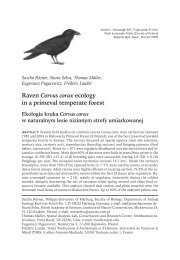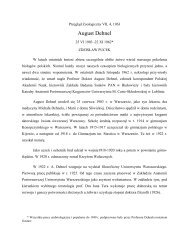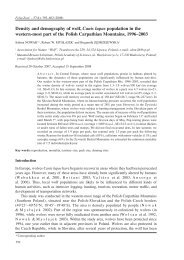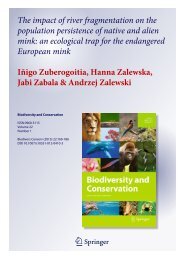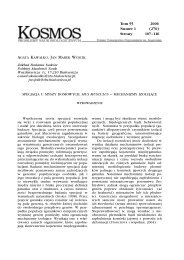Mammalian fauna of indigenous forest in the Transkei region of ...
Mammalian fauna of indigenous forest in the Transkei region of ...
Mammalian fauna of indigenous forest in the Transkei region of ...
Create successful ePaper yourself
Turn your PDF publications into a flip-book with our unique Google optimized e-Paper software.
<strong>Mammalian</strong> <strong>fauna</strong> <strong>of</strong> <strong><strong>in</strong>digenous</strong> <strong>forest</strong> <strong>in</strong><br />
<strong>the</strong> <strong>Transkei</strong> <strong>region</strong> <strong>of</strong> South Africa:<br />
an overdue survey<br />
Matt W. Hayward*, Rehema M. White, Khayalethu M. Mabandla & Pakama Bukeye<br />
Department <strong>of</strong> Zoology, University <strong>of</strong> <strong>Transkei</strong>, Private Bag X1, UNITRA, Umtata, 5117 South Africa<br />
Received 12 January 2005. Accepted 13 April 2005<br />
The <strong>Transkei</strong> <strong>region</strong> <strong>of</strong> <strong>the</strong> Eastern Cape has received little attention from mammalian<br />
ecologists. This paper describes <strong>the</strong> presence and absence <strong>of</strong> mammalian species <strong>in</strong><br />
Afromontane, Pondoland and south coast <strong><strong>in</strong>digenous</strong> <strong>forest</strong>s us<strong>in</strong>g variable width transects<br />
and explores <strong>the</strong> causes <strong>of</strong> observed differences. The <strong>region</strong> ma<strong>in</strong>ta<strong>in</strong>s a rich and diverse<br />
mammalian <strong>fauna</strong>, although differences between <strong>forest</strong> types exist. Ungulates (bushbuck,<br />
Tragelaphus scriptus; common duiker, Sylvicapra grimmia; and blue duiker, Cephalophus<br />
monticola) and fossorially-forag<strong>in</strong>g (bushpigs, porcup<strong>in</strong>es and moles/molerats) species are<br />
relatively more abundant <strong>in</strong> south coast <strong>forest</strong>s than <strong>in</strong> Afromontane or Pondoland <strong>forest</strong><br />
types. This may be expla<strong>in</strong>ed by <strong>the</strong> management practices <strong>of</strong> <strong>the</strong>se nature reserves compared<br />
to state <strong>forest</strong>s.<br />
Key words: basel<strong>in</strong>e survey, conservation, <strong>forest</strong>, mammals, ungulates.<br />
INTRODUCTION<br />
Forest covers less than one per cent <strong>of</strong> <strong>the</strong> area <strong>of</strong><br />
South Africa and is <strong>the</strong> smallest biome <strong>in</strong> <strong>the</strong><br />
country (Low & Rebelo 1996). Broadly, <strong>the</strong>se<br />
<strong>forest</strong>s have been classified as Afromontane and<br />
coastal <strong><strong>in</strong>digenous</strong> <strong>forest</strong>s. Despite <strong>the</strong>ir small size,<br />
only 17.6% <strong>of</strong> Afromontane and 9.5% <strong>of</strong> coastal<br />
<strong>forest</strong>s occur <strong>in</strong> declared conservation areas (Low<br />
& Rebelo 1996) and <strong>the</strong> various management<br />
forms <strong>of</strong> <strong>the</strong>se areas are considered to provide low<br />
conservation efficiency (Castley & Kerley 1996) .<br />
The majority <strong>of</strong> <strong>forest</strong>ed area (47.6% <strong>of</strong> Afromontane<br />
and 95.8% <strong>of</strong> coastal) rema<strong>in</strong><strong>in</strong>g <strong>in</strong> South<br />
Africa occur as fragments <strong>in</strong> <strong>the</strong> Eastern Cape<br />
Prov<strong>in</strong>ce (Low & Rebelo 1996) and approximately<br />
61 000 ha rema<strong>in</strong>s <strong>in</strong> <strong>the</strong> former ‘Republic <strong>of</strong><br />
<strong>Transkei</strong>’ <strong>region</strong> (von Maltitz & Flem<strong>in</strong>g 2000).<br />
Coastal <strong><strong>in</strong>digenous</strong> <strong>forest</strong> types <strong>in</strong> this <strong>region</strong> have<br />
been fur<strong>the</strong>r separated <strong>in</strong>to south coast and<br />
Pondoland coastal <strong>forest</strong> (Cooper & Swart 1992).<br />
Indigenous <strong>forest</strong> is <strong>of</strong> high conservation value<br />
with 14% <strong>of</strong> threatened South African vertebrates<br />
occurr<strong>in</strong>g <strong>the</strong>re despite <strong>the</strong> small area <strong>the</strong>y cover<br />
(Castley & Kerley 1996), yet little is known about<br />
it or <strong>the</strong> <strong>fauna</strong> <strong>in</strong>habit<strong>in</strong>g it, particularly <strong>in</strong> <strong>the</strong><br />
<strong>Transkei</strong> <strong>region</strong>. Very few historical descriptions <strong>of</strong><br />
<strong>the</strong> <strong>fauna</strong> <strong>of</strong> <strong>the</strong> <strong>region</strong> exist. However, those that<br />
do <strong>in</strong>dicate <strong>fauna</strong> was abundant and diverse <strong>in</strong> <strong>the</strong><br />
*To whom correspondence should be addressed. Terrestrial Ecology<br />
Research Unit, Department <strong>of</strong> Zoology, Nelson Mandela Metropolitan<br />
University, P.O. Box 77000, Port Elizabeth, 6031 South Africa.<br />
E-mail: hayers111@aol.com<br />
<strong>forest</strong>s <strong>of</strong> <strong>the</strong> <strong>Transkei</strong> when Europeans arrived<br />
(Skead 1987). Today, <strong>the</strong> ecological <strong>in</strong>tegrity <strong>of</strong><br />
this biome is becom<strong>in</strong>g <strong>in</strong>creas<strong>in</strong>gly threatened<br />
due to habitat destruction and modification that <strong>of</strong>ten<br />
arises with a rapid population expansion<br />
(Castley & Kerley 1996; de Villiers & White 2002;<br />
White 2001). Uncontrolled hunt<strong>in</strong>g occurs <strong>in</strong> <strong>the</strong><br />
<strong>Transkei</strong>’s <strong><strong>in</strong>digenous</strong> <strong>forest</strong>s despite <strong>the</strong> derived<br />
meat not be<strong>in</strong>g a major source <strong>of</strong> nutrition <strong>in</strong><br />
traditional communities (White 2001). Increas<strong>in</strong>g<br />
access to <strong>forest</strong>s, hunt<strong>in</strong>g by people from outside<br />
local communities, use <strong>of</strong> high technology weapons<br />
(guns) and changes <strong>in</strong> utilization practices by local<br />
communities threaten <strong>the</strong> <strong><strong>in</strong>digenous</strong> <strong>fauna</strong> that<br />
form an <strong>in</strong>tegral component <strong>of</strong> <strong>the</strong> ecosystem<br />
(White 2001; de Villiers & White 2002). Fur<strong>the</strong>rmore,<br />
<strong>the</strong> redirection from exclusion policies <strong>in</strong><br />
<strong>the</strong> conservation estate to ones <strong>of</strong> participatory<br />
management (e.g. National Forest Act 1998) have<br />
led to a desire by local communities to harvest<br />
resources, <strong>in</strong>clud<strong>in</strong>g wildlife, <strong>in</strong> a susta<strong>in</strong>able<br />
fashion. Consequently, managers are seek<strong>in</strong>g<br />
<strong>in</strong>formation on <strong>fauna</strong>l species richness and<br />
diversity to estimate what levels, if any, <strong>of</strong> hunt<strong>in</strong>g<br />
are susta<strong>in</strong>able and which species should be<br />
managed. This paper aims to provide an <strong>in</strong>dication<br />
<strong>of</strong> <strong>the</strong> occurrence <strong>of</strong> mammalian <strong>fauna</strong> <strong>in</strong> <strong>the</strong><br />
<strong><strong>in</strong>digenous</strong> <strong>forest</strong>s <strong>of</strong> <strong>the</strong> <strong>Transkei</strong> by compar<strong>in</strong>g<br />
relative species richness and diversity <strong>in</strong> <strong>the</strong> three<br />
<strong>forest</strong> types <strong>of</strong> <strong>the</strong> <strong>region</strong> us<strong>in</strong>g <strong>in</strong>direct census<br />
methods.<br />
South African Journal <strong>of</strong> Wildlife Research 35(2): 117–124 (October 2005)
118 South African Journal <strong>of</strong> Wildlife Research Vol. 35, No. 2, October 2005<br />
Fig. 1. Location map <strong>of</strong> <strong>the</strong> studied <strong>forest</strong>s. The Dwesa and Cwebe Nature Reserves are classified as south coast<br />
<strong>forest</strong>s, <strong>forest</strong>s near Port St Johns as Pondoland <strong>forest</strong>s, and <strong>the</strong> Afromontane <strong>forest</strong>s surveyed were 30 km northwest<br />
<strong>of</strong> Umtata.<br />
STUDY SITES<br />
South coast, Pondoland and Afromontane <strong>forest</strong>s<br />
were surveyed throughout <strong>the</strong> <strong>Transkei</strong> <strong>region</strong>.<br />
The two adjacent south coast <strong>forest</strong>s surveyed<br />
(Cwebe and Dwesa Nature Reserves) lie on <strong>the</strong><br />
coast approximately 200 km south <strong>of</strong> Umtata<br />
(Fig. 1) between 32°12’and 32°20’S and 28°48’<br />
and 28°58’E and cover an area <strong>of</strong> 15 254 ha<br />
(Timmermans & Naicker 2002). Pondoland coastal<br />
<strong><strong>in</strong>digenous</strong> <strong>forest</strong>s were surveyed <strong>in</strong> <strong>the</strong> Port<br />
St Johns area (31°21’S, 29°30’E), and formed<br />
a semi-cont<strong>in</strong>ous block <strong>of</strong> coastal <strong>forest</strong> that<br />
<strong>in</strong>cludes <strong>the</strong> Silaka Nature Reserve and Mt<br />
Thesiger. The Afromontane <strong>forest</strong>s surveyed were<br />
30 km northwest <strong>of</strong> Umtata <strong>in</strong> <strong>the</strong> Matiwane Range<br />
(31° 30’S, 28°30’ E). The <strong>forest</strong> blocks surveyed <strong>in</strong><br />
this Afromontane <strong>forest</strong> lie between 1127 m and<br />
1192 m above sea level. The Pondoland and Afromontane<br />
<strong>forest</strong>s are categorized as State Forests<br />
and hence are largely protected, although limited<br />
use <strong>of</strong> some resources (e.g. firewood and medic<strong>in</strong>al<br />
plants) by local people is permitted. Hunt<strong>in</strong>g <strong>in</strong><br />
all <strong>the</strong>se <strong>forest</strong>s is ostensibly illegal but <strong>in</strong> practice<br />
poach<strong>in</strong>g has occurred <strong>in</strong> all <strong>forest</strong>s. In addition,<br />
several species have been <strong>in</strong>troduced to <strong>the</strong><br />
Dwesa and Cwebe Nature Reserves by <strong>the</strong> Department<br />
<strong>of</strong> Water Affairs and Forestry.<br />
METHODS<br />
South coast <strong><strong>in</strong>digenous</strong> <strong>forest</strong> was surveyed<br />
between March and July 2003 by 67 transects<br />
totall<strong>in</strong>g 80 observer hours. Pondoland coastal<br />
<strong>forest</strong>s and Afromontane <strong>forest</strong>s were surveyed<br />
between June and August 1999. Pondoland<br />
coastal <strong>forest</strong>s were subject to 11 transects totall<strong>in</strong>g<br />
132 observer hours and Afromontane <strong>forest</strong>s<br />
to 15 transects totall<strong>in</strong>g 68 observer hours.<br />
Multiple variable-width l<strong>in</strong>e transects were<br />
walked through all <strong>forest</strong>s by between two and four<br />
people on each visit. On each transect, observers<br />
walked approximately 5 m apart through <strong>the</strong> <strong>forest</strong><br />
on routes perpendicular to tracks record<strong>in</strong>g direct<br />
and <strong>in</strong>direct evidence <strong>of</strong> all wildlife, such as observations,<br />
spoor, dung and digg<strong>in</strong>gs, based on published<br />
field guides (Stuart & Stuart 1994) and<br />
experience. The degree <strong>of</strong> experience <strong>in</strong> identify<strong>in</strong>g<br />
cryptic sign <strong>in</strong> <strong>the</strong> <strong>Transkei</strong>an <strong>forest</strong>s varied<br />
among <strong>the</strong> surveyors, with R.M.W. hav<strong>in</strong>g several<br />
years experience survey<strong>in</strong>g mammal sign around<br />
<strong>Transkei</strong> villages assisted by <strong>the</strong> same three technical<br />
<strong>of</strong>ficers that participated <strong>in</strong> this study.<br />
M.W.H., K.M.M. and P.B. had substantially less<br />
experience (up to one year) but were always<br />
accompanied by R.M.W. or a technical <strong>of</strong>ficer with<br />
whom <strong>the</strong>y checked <strong>the</strong>ir identification.
Hayward et al.: <strong>Mammalian</strong> <strong>fauna</strong> <strong>of</strong> <strong><strong>in</strong>digenous</strong> <strong>forest</strong> <strong>in</strong> <strong>the</strong> <strong>Transkei</strong> <strong>region</strong> <strong>of</strong> South Africa 119<br />
Table 1. Orthogonal solution <strong>of</strong> a pr<strong>in</strong>cipal components factor analysis <strong>of</strong> habitat variables measured <strong>in</strong> <strong>the</strong> three<br />
<strong>forest</strong> types. The explanatory variables <strong>in</strong> each factor are shown <strong>in</strong> bold.<br />
Variable Habitat factor 1 Habitat factor 2 Habitat factor 3<br />
Bare earth cover 0.591 0.681 0.209<br />
Rock cover 0.752 –0.147 –0.270<br />
Vegetation cover 0.187 –0.633 0.653<br />
Leaf litter cover –0.807 0.014 –0.528<br />
Canopy cover –0.144 0.894 0.057<br />
Vegetation density –0.053 0.129 0.764<br />
Variance expla<strong>in</strong>ed (%) 32.6 28.5 17.9<br />
Bushpigs (Potamochoerus larvatus), porcup<strong>in</strong>es<br />
(Hystrix africaeaustralis) and mole/molerats<br />
are grouped toge<strong>the</strong>r <strong>in</strong> several analyses. Consequently,<br />
we used <strong>the</strong> phrase ‘fossorial species’ for<br />
<strong>the</strong>m. This is not <strong>the</strong> strict zoological useage <strong>of</strong> <strong>the</strong><br />
term fossorial but we use it here to reflect <strong>the</strong>ir<br />
forag<strong>in</strong>g strategy.<br />
Human disturbance levels, based on observations<br />
<strong>of</strong> woodcutt<strong>in</strong>g, snares or hunt<strong>in</strong>g, were<br />
recorded <strong>in</strong> <strong>the</strong> same manner. An <strong>in</strong>dex <strong>of</strong> relative<br />
abundance was <strong>the</strong>n calculated by divid<strong>in</strong>g <strong>the</strong><br />
number <strong>of</strong> observations <strong>of</strong> evidence by <strong>the</strong> number<br />
<strong>of</strong> observer hours on each transect. A comparative<br />
<strong>in</strong>dex <strong>of</strong> evidence per kilometre <strong>of</strong> each transect<br />
was not calculated due to <strong>the</strong> lack <strong>of</strong> accurate<br />
global position<strong>in</strong>g system or map locations for <strong>the</strong><br />
earlier surveys. Habitat attributes measured were<br />
subjective estimates <strong>of</strong> percentage cover <strong>of</strong> bare<br />
earth, rock, vegetation and leaf litter; vegetation<br />
density at 1 m above ground (on a scale from 1:<br />
visibility to 20 m to 5: visibility
120 South African Journal <strong>of</strong> Wildlife Research Vol. 35, No. 2, October 2005<br />
Fig. 2. Plot <strong>of</strong> mean (±S.E.) habitat factor scores 2 (canopy cover) and 3 (vegetation density at 1 m) for each <strong>forest</strong><br />
type.<br />
<strong>forest</strong>s when <strong>in</strong>troduced species were <strong>in</strong>cluded<br />
(F 2,85<br />
= 3.1, P < 0.05; Scheffe’s post hoc test P <<br />
0.02) (Table 2; Fig. 4).<br />
Factor analysis was used to reduce <strong>the</strong> seven<br />
most common <strong>fauna</strong> species to three factor scores<br />
which expla<strong>in</strong>ed 58.5% <strong>of</strong> <strong>the</strong> variance <strong>in</strong> <strong>the</strong> data<br />
(Bartlett’s χ 2 = 113.5, d.f. = 35, P < 0.01). Fauna<br />
factor 1 related to high abundance <strong>of</strong> fossorial<br />
mammals (bushpig, mole/molerat and Cape<br />
porcup<strong>in</strong>e) and expla<strong>in</strong>ed 30.5% <strong>of</strong> <strong>the</strong> variance<br />
(Table 3). Fauna factor 2 reflected a high abundance<br />
<strong>of</strong> ungulates (blue duiker, Cephalophus<br />
monticola; bushbuck, Tragelaphus scriptus and<br />
common duiker, Sylvicapra grimmia) and ex-<br />
Table 2. Mammal species found <strong>in</strong> <strong>the</strong> three <strong>forest</strong> types and <strong>the</strong>ir mean relative abundance (evidence per observer<br />
hour). Introduced species are denoted with an ‘‡’. Species that were only recorded once are listed as ‘present’.<br />
Species richness is shown <strong>in</strong> bold <strong>in</strong>clud<strong>in</strong>g and exclud<strong>in</strong>g (<strong>in</strong> brackets) those species <strong>in</strong>troduced to <strong>the</strong> <strong>region</strong>.<br />
Common and scientific name Afromontane Pondoland South coast<br />
African buffalo, ‡ Syncerus caffer 0.1<br />
African wild cat, Felis lybica<br />
Present<br />
Black-backed jackal, Canis mesomelas<br />
Present<br />
Blue duiker, Philantomba monticola 0.1 0.6 1.0<br />
Blue wildebeest, ‡ Connochaetes taur<strong>in</strong>us Present 0.3<br />
Burchell’s zebra, ‡ Equus burchelli Present 1.6<br />
Bushbuck, Tragelaphus scriptus 0.4 0.3 2.8<br />
Bushpig, Potamochoerus porcus 0.1 3.1 0.3<br />
Cape clawless otter, Aonyx capensis Present 0.1 0.1<br />
Cape porcup<strong>in</strong>e, Hystrix africaeaustralis Present 0.2 1.2<br />
Common duiker, Sylvicapra grimmia 0.1 0.3 0.7<br />
Mole/Mole-rat a Present Present 2.7<br />
Eland, ‡ Taurotragus oryx<br />
Present<br />
Large-spotted genet, Genetta tigr<strong>in</strong>a Present 0.3 0.1<br />
Samango monkey, Cercopi<strong>the</strong>cus mitis 0.1<br />
Spotted-necked otter, Lutra maculicollis<br />
Present<br />
Tree hyrax, Dendrohyrax arboreus<br />
Present<br />
Rock hyrax, Procavia capensis<br />
Present<br />
Vervet monkey, Cercopi<strong>the</strong>cus aethiops Present 0.2 0.1<br />
Water mongoose, Atilax palud<strong>in</strong>osus Present 0.1 0.1<br />
White rh<strong>in</strong>oceros, ‡ Cerato<strong>the</strong>rium simum 0.2<br />
Species richness (exclud<strong>in</strong>g <strong>in</strong>trod. sp.) 12 (12) 13 (11) 18 (14)<br />
a Heaps <strong>of</strong> moles or molerats were assumed to be Hottentot golden mole (Amblysomus hottentotus) or common mole-rat (Cryptomys<br />
hottentotus), respectively, based on distribution and habitat requirements.
Hayward et al.: <strong>Mammalian</strong> <strong>fauna</strong> <strong>of</strong> <strong><strong>in</strong>digenous</strong> <strong>forest</strong> <strong>in</strong> <strong>the</strong> <strong>Transkei</strong> <strong>region</strong> <strong>of</strong> South Africa 121<br />
Fig. 3. Plot <strong>of</strong> mean (±S.E.) relative species richness per transect <strong>of</strong> <strong>the</strong> three <strong>forest</strong> types <strong>in</strong>clud<strong>in</strong>g and exclud<strong>in</strong>g<br />
mammal species that have been <strong>in</strong>troduced to <strong>the</strong> <strong>region</strong>.<br />
Fig. 4. Plot <strong>of</strong> mean (±S.E.) Shannon-We<strong>in</strong>er species diversity <strong>in</strong>dex values (H’) per transect <strong>of</strong> <strong>the</strong> three <strong>forest</strong> types<br />
<strong>in</strong>clud<strong>in</strong>g and exclud<strong>in</strong>g mammal species that have been <strong>in</strong>troduced to <strong>the</strong> <strong>region</strong>.<br />
pla<strong>in</strong>ed 15.2% <strong>of</strong> <strong>the</strong> variance and <strong>fauna</strong> factor 3<br />
reflects high abundance <strong>of</strong> vervet monkeys<br />
(Cercopi<strong>the</strong>cus aethiops) and expla<strong>in</strong>ed 12.8% <strong>of</strong><br />
<strong>the</strong> variance (Table 3).<br />
South coast <strong>forest</strong> had significantly more evidence<br />
<strong>of</strong> fossorially-forag<strong>in</strong>g mammals than <strong>the</strong> o<strong>the</strong>r<br />
two <strong>forest</strong> types (ANOVA F 2,90<br />
= 7.28, P < 0.01;<br />
Scheffe’s post hoc test P < 0.03 for south coast<br />
comparisons with Afromontane and Pondoland<br />
<strong>forest</strong> types). South coast <strong>forest</strong>s also had signifi-<br />
Table 3. Orthogonal solution <strong>of</strong> a pr<strong>in</strong>cipal components factor analysis <strong>of</strong> <strong>the</strong> relative abundance (evidence per<br />
observer hour) <strong>of</strong> <strong>the</strong> seven most abundant <strong>fauna</strong> species measured at <strong>the</strong> three <strong>forest</strong> types. The most important<br />
variables <strong>in</strong> each factor are shown <strong>in</strong> bold.<br />
Variable Fauna factor 1 Fauna factor 2 Fauna factor 3<br />
Blue duiker 0.181 0.570 0.071<br />
Bushbuck 0.495 0.516 0.079<br />
Bushpig 0.784 0.166 –0.037<br />
Common duiker –0.175 0.831 –0.096<br />
Mole/Molerat 0.825 0.072 0.155<br />
Cape porcup<strong>in</strong>e 0.828 –0.070 –0.107<br />
Vervet monkey 0.042 0.006 0.985<br />
Variance expla<strong>in</strong>ed 30.5% 15.2% 12.8%
122 South African Journal <strong>of</strong> Wildlife Research Vol. 35, No. 2, October 2005<br />
Fig. 5. Plot <strong>of</strong> mean (±S.E.) <strong>fauna</strong> factor scores 1 (related to high abundance <strong>of</strong> bushpig, mole/molerat and Cape<br />
porcup<strong>in</strong>e) and 2 (related to a high abundance <strong>of</strong> blue duiker, bushbuck and common duiker) for each <strong>forest</strong> type.<br />
Table 4. Kruskal-Wallis ANOVA on ranks test results for mammal species recorded <strong>in</strong> each <strong>of</strong> <strong>the</strong> <strong>forest</strong> types. ‘H’ is<br />
<strong>the</strong> Kruskal-Wallis H statistic corrected for ties; and <strong>the</strong> f<strong>in</strong>al three columns are <strong>the</strong> mean rank for each <strong>forest</strong> type.<br />
Degrees <strong>of</strong> freedom are two for all comparisons. Significant results are shown <strong>in</strong> bold.<br />
Species H Probability Afromontane Pondoland South Coast<br />
Blue duiker 4.28 0.12 33.1 53.6 47.7<br />
Bushbuck 29.59
Hayward et al.: <strong>Mammalian</strong> <strong>fauna</strong> <strong>of</strong> <strong><strong>in</strong>digenous</strong> <strong>forest</strong> <strong>in</strong> <strong>the</strong> <strong>Transkei</strong> <strong>region</strong> <strong>of</strong> South Africa 123<br />
<strong>the</strong>y move <strong>in</strong>to <strong>the</strong> <strong>forest</strong> dur<strong>in</strong>g <strong>the</strong> day to avoid<br />
human contact and <strong>the</strong>n move out onto <strong>the</strong> pla<strong>in</strong>s<br />
at night to forage.<br />
The species list reported here is not all-<strong>in</strong>clusive<br />
s<strong>in</strong>ce l<strong>in</strong>e transects do not identify all species<br />
present and <strong>in</strong>cidental observations have been<br />
made <strong>of</strong> numerous o<strong>the</strong>r species. Samango<br />
monkeys (Cercopi<strong>the</strong>cus mitis) have been <strong>in</strong>cidentally<br />
observed <strong>in</strong> Afromontane and Pondoland<br />
<strong>forest</strong>s, tree hyrax have been heard <strong>in</strong> Pondoland<br />
and South Coast <strong>forest</strong>s (R.M.W., unpubl. data)<br />
and black-backed jackal spoor has been observed<br />
<strong>in</strong> Afromontane <strong>forest</strong>s (M.W.H., unpubl.data).Additionally,<br />
it is expected that African wild cat, spotted-necked<br />
otter and, particularly, rock hyrax<br />
Procavia capensis all occur <strong>in</strong> appropriate habitats<br />
throughout <strong>the</strong> <strong>forest</strong>s <strong>of</strong> <strong>the</strong> <strong>Transkei</strong> (R.M.W.,<br />
unpubl. data). There have also been <strong>in</strong>cidental<br />
sight<strong>in</strong>gs <strong>of</strong> caracal (Felis caracal) and leopard<br />
(Pan<strong>the</strong>ra pardus) <strong>in</strong> south coast <strong>forest</strong>s (M.<br />
Mbete, Dwesa-Cwebe Nature Reserve Manager,<br />
pers. comm.). Observations <strong>of</strong> <strong>the</strong> latter were confirmed<br />
<strong>in</strong> 2004 (P. Roberts, pers. comm.).<br />
Confusion arises over <strong>the</strong> orig<strong>in</strong>al status <strong>of</strong><br />
several species that have been <strong>in</strong>troduced to <strong>the</strong><br />
<strong>region</strong>. These <strong>in</strong>clude blue wildebeest, buffalo,<br />
Burchell’s zebra, eland and white rh<strong>in</strong>oceros<br />
which are thought never to have occurred <strong>the</strong>re but<br />
were never<strong>the</strong>less <strong>in</strong>troduced (Feely 1999; de<br />
Villiers 2002). Historical reports, however, suggest<br />
buffalo and eland were common (Skead 1987).<br />
Similarly <strong>the</strong> ext<strong>in</strong>ct quagga was common<br />
throughout <strong>the</strong> <strong>Transkei</strong> (Skead 1987) and, if we<br />
consider it merely a subspecies <strong>of</strong> Burchell’s<br />
zebra, <strong>the</strong>n it too orig<strong>in</strong>ally occurred <strong>the</strong>re.<br />
Several o<strong>the</strong>r species have gone ext<strong>in</strong>ct <strong>in</strong> <strong>the</strong><br />
<strong>Transkei</strong> s<strong>in</strong>ce <strong>the</strong> arrival <strong>of</strong> settlers. These <strong>in</strong>clude<br />
elephant (Loxodonta africana), warthog (Phacochoerus<br />
aethiopicus), hippopotamus (Hippopotamus<br />
amphibius), lion (Pan<strong>the</strong>ra leo), African wild<br />
dog (Lycaon pictus) and spotted hyaena (Crocuta<br />
crocuta) (Skead 1987; de Villiers 2002). Even<br />
with<strong>in</strong> <strong>the</strong> conservation reserves <strong>of</strong> Dwesa and<br />
Cwebe, recent local ext<strong>in</strong>ctions have occurred <strong>in</strong><br />
<strong>in</strong>troduced but extralimital populations <strong>of</strong> blesbok<br />
(Damaliscus dorcas) and blue wildebeest, respectively<br />
(M. Mbete, pers. comm.).<br />
The greater abundance <strong>of</strong> ungulates and fossorial<br />
species <strong>in</strong> <strong>the</strong> south coast <strong>forest</strong>s than<br />
Afromontane or Pondoland coastal <strong>forest</strong>s is not<br />
attributable to <strong>the</strong> level <strong>of</strong> human disturbance or to<br />
<strong>the</strong> habitat features we measured. Signs <strong>of</strong> hunt<strong>in</strong>g<br />
parties were never observed on transects but <strong>the</strong>y<br />
are less likely to leave evidence <strong>of</strong> <strong>the</strong>ir presence<br />
as <strong>the</strong>y enter <strong>the</strong> <strong>forest</strong>s to hunt ra<strong>the</strong>r than to set<br />
snares, and thus hunt<strong>in</strong>g may be <strong>the</strong> cause <strong>of</strong> <strong>the</strong><br />
observed differences. The south coast <strong>forest</strong>s<br />
may have lower levels <strong>of</strong> hunt<strong>in</strong>g because <strong>the</strong>y are<br />
managed as nature reserves, whereas <strong>the</strong><br />
Afromontane and Pondoland <strong>forest</strong>s are managed<br />
as state <strong>forest</strong>s. Both <strong>forest</strong> management types,<br />
however, employ guards to prevent poach<strong>in</strong>g.<br />
Hunt<strong>in</strong>g may expla<strong>in</strong> differences <strong>in</strong> abundance <strong>of</strong><br />
ungulates and bushpig; however, soil structural<br />
differences probably expla<strong>in</strong> <strong>the</strong> greater abundance<br />
<strong>of</strong> mole/molerats at <strong>the</strong> south coast <strong>forest</strong><br />
sites.<br />
It is unlikely that <strong>the</strong> greater abundances <strong>in</strong> south<br />
coast <strong>forest</strong>s are due to <strong>the</strong> slight methodological<br />
differences between <strong>the</strong> three surveys. Transects<br />
<strong>in</strong> Afromontane and Pondoland <strong>forest</strong>s were fewer,<br />
but longer and more closely spaced, than those <strong>in</strong><br />
<strong>the</strong> south coast. However, <strong>the</strong> more abundant<br />
species <strong>in</strong> <strong>the</strong> south coast <strong>forest</strong>s are those<br />
species that would be distributed fairly homogeneously<br />
and close toge<strong>the</strong>r throughout <strong>the</strong> <strong>forest</strong>,<br />
as opposed to predators which may be more<br />
widely spaced.<br />
The greater abundance <strong>of</strong> large-spotted genets<br />
and vervet monkeys <strong>in</strong> Pondoland coastal <strong>forest</strong>s<br />
may be attributable to <strong>the</strong> high floristic diversity<br />
<strong>the</strong>re, as <strong>the</strong> <strong>region</strong> is known as a centre <strong>of</strong><br />
endemism. Both species <strong>in</strong>clude plant material <strong>in</strong><br />
<strong>the</strong>ir diet (Sk<strong>in</strong>ner & Smi<strong>the</strong>rs 1990) and a high<br />
floristic diversity may provide more <strong>in</strong>vertebrate<br />
food than is available <strong>in</strong> south coast and Afromontane<br />
<strong>forest</strong>s.<br />
While this study affords a prelim<strong>in</strong>ary look at <strong>the</strong><br />
larger and more obvious mammalian <strong>fauna</strong> <strong>of</strong> <strong>the</strong><br />
<strong>Transkei</strong> <strong>region</strong>, <strong>the</strong>re is much more <strong>in</strong>formation to<br />
be ga<strong>the</strong>red from this relatively unknown area.<br />
Ongo<strong>in</strong>g work is explor<strong>in</strong>g <strong>the</strong> impacts <strong>of</strong> hunt<strong>in</strong>g<br />
and <strong>the</strong> factors affect<strong>in</strong>g mammalian distribution <strong>in</strong><br />
more detail.<br />
ACKNOWLEDGEMENTS<br />
We thank M. Mbete, Manager <strong>of</strong> Dwesa and<br />
Cwebe Nature Reserves for approval to work<br />
<strong>the</strong>re. Mzo Nkaitshana, S<strong>in</strong>tu Pondoland Hola and<br />
Chawe greatly assisted <strong>in</strong> all field work. The<br />
National Research Foundation (NRF) provided<br />
postdoctoral fund<strong>in</strong>g to M.W.H. <strong>in</strong> South Africa<br />
and for project costs.M.Somers, G.Kerley and two<br />
anonymous reviewers provided valuable reviews<br />
<strong>of</strong> this manuscript.
124 South African Journal <strong>of</strong> Wildlife Research Vol. 35, No. 2, October 2005<br />
REFERENCES<br />
CASTLEY, J.G. & KERLEY, G.I.H. 1996. The paradox<br />
<strong>of</strong> <strong>forest</strong> conservation <strong>in</strong> South Africa. Forest Ecol.<br />
Manage. 85: 35–46.<br />
COOPER, K.H. & SWART, W. 1992. <strong>Transkei</strong> Forest<br />
Survey. Wildlife Society <strong>of</strong> Sou<strong>the</strong>rn Africa, Durban.<br />
DE VILLIERS, D.J. 2002. Impacts <strong>of</strong> human and biological<br />
factors on distributions <strong>of</strong> <strong><strong>in</strong>digenous</strong> mammals <strong>in</strong><br />
<strong>Transkei</strong>: with particular emphasis on <strong>forest</strong> dwell<strong>in</strong>g<br />
bushbuck (Tragelaphus scriptus), blue duiker<br />
(Philantomba monticola) and bushpig (Potamochoerus<br />
porcus). M.Sc. <strong>the</strong>sis, University <strong>of</strong> <strong>Transkei</strong>,<br />
Umtata.<br />
DE VILLIERS, D.J. & WHITE, R.M. 2002. Are current<br />
conservation practices conserv<strong>in</strong>g <strong><strong>in</strong>digenous</strong> <strong>forest</strong><br />
<strong>fauna</strong> In: A.H.W. Seydack, T. Vorster, W.J.<br />
Vermeulen & I.J. van der Merwe (Eds), Multiple use<br />
management <strong>of</strong> natural <strong>forest</strong>s and woodlands:<br />
policy ref<strong>in</strong>ements and scientific progress. Natural<br />
Forests and Savanna Woodlands Symposium III<br />
(pp. 110–121). Department <strong>of</strong> Water Affairs and<br />
Forestry, Pretoria.<br />
FEELY, J. 1999. Historical distribution <strong>of</strong> some larger<br />
mammals <strong>in</strong> <strong>Transkei</strong>. Department <strong>of</strong> Economic<br />
Affairs, Environment and Tourism, Pretoria, South<br />
Africa.<br />
LOW, A.B. & REBELO, T.G. 1996. Vegetation <strong>of</strong> South<br />
Africa, Lesotho and Swaziland. Department <strong>of</strong><br />
Environmental Affairs and Tourism, Pretoria.<br />
SKEAD, C.J. 1987. Historical mammal <strong>in</strong>cidence <strong>in</strong> <strong>the</strong><br />
Cape Prov<strong>in</strong>ce, <strong>in</strong>clud<strong>in</strong>g <strong>the</strong> Ciskei, <strong>Transkei</strong> and<br />
east Griqualand. Chief Directorate <strong>of</strong> Nature and<br />
Environmental Conservation <strong>of</strong> <strong>the</strong> Prov<strong>in</strong>cial Adm<strong>in</strong>istration<br />
<strong>of</strong> <strong>the</strong> Cape <strong>of</strong> Good Hope, Cape Town.<br />
SKINNER, J.D. & SMITHERS, R.H.N. 1990. The<br />
mammals <strong>of</strong> <strong>the</strong> sou<strong>the</strong>rn African sub<strong>region</strong>. University<br />
<strong>of</strong> Pretoria, Pretoria.<br />
STUART, C. & STUART, T. 1994. A field guide to <strong>the</strong><br />
tracks and signs <strong>of</strong> sou<strong>the</strong>rn and east African wildlife.<br />
Sou<strong>the</strong>rn Book Publishers, Halfway House, South<br />
Africa.<br />
TIMMERMANS, H. & NAICKER, K. 2002. The land. In<br />
R. Palmer, H. Timmermans & D. Fay (Eds), From<br />
conflict to negotiation: nature-based development<br />
on South Africa’s Wild Coast (pp. 2–14). Human Sciences<br />
Research Council, Pretoria.<br />
VON MALTITZ, G.P. & FLEMING, G. 2000. Status <strong>of</strong><br />
conservation <strong>of</strong> <strong><strong>in</strong>digenous</strong> <strong>forest</strong>s <strong>in</strong> South Africa. In:<br />
A. Seydack, W.J. Vermeulen & C. Vermeulen (Eds),<br />
Towards susta<strong>in</strong>able management based on scientific<br />
understand<strong>in</strong>g <strong>of</strong> natural <strong>forest</strong>s and woodlands,<br />
(pp. 93–99). Department <strong>of</strong> Water Affairs and<br />
Forestry, Knysna, South Africa.<br />
WHITE, R. M. 2001. Patterns <strong>of</strong> utilisation <strong>of</strong> <strong><strong>in</strong>digenous</strong><br />
<strong>fauna</strong> and o<strong>the</strong>r natural resources by local communities<br />
from <strong>Transkei</strong> <strong>forest</strong>s (94 pp.). Unpublished<br />
reportPrepared for <strong>the</strong> Department <strong>of</strong> Water Affairs<br />
and Forestry, Pretoria, South Africa.



